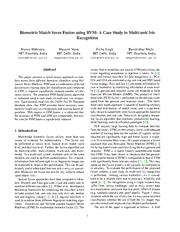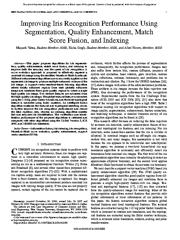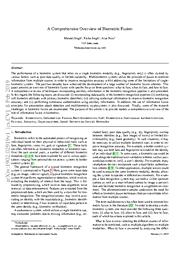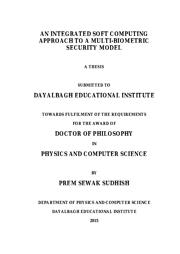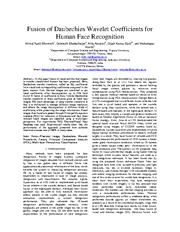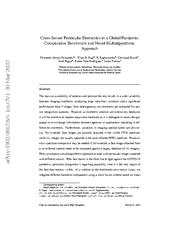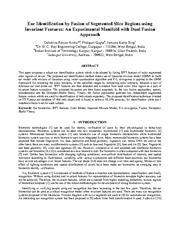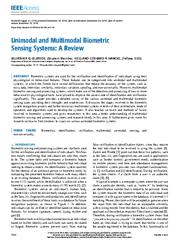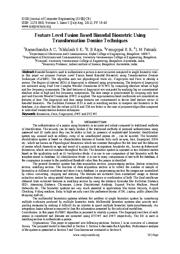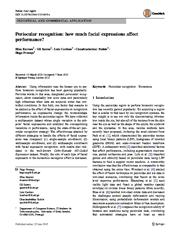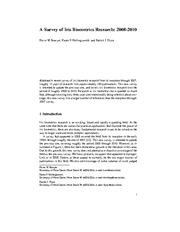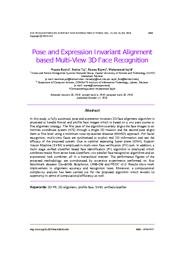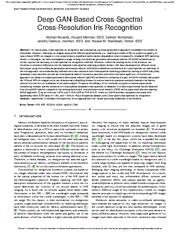A copy of this work was available on the public web and has been preserved in the Wayback Machine. The capture dates from 2020; you can also visit the original URL.
The file type is application/pdf.
Filters
Score Fusion Strategies in Single-Iris Dual-Probe Recognition Systems
2018
Proceedings of the 2018 2nd International Conference on Biometric Engineering and Applications - ICBEA '18
It has been shown, that in a single-instance dual-probe setup, fusing the probe scores yields significant biometric performance increase over the single-probe baseline. ...
Additionally, using the probe-probe comparison score was demonstrated to further improve the biometric performance of a fingerprint recognition system in a study by Cheng et al. ...
The remainder of this paper is organised as follows: in section 2, the fusion strategies for single-iris dual-probe iris recognition are described. ...
doi:10.1145/3230820.3230823
dblp:conf/icbea/DrozdowskiWRB18
fatcat:lc3lohtycjcvrd72kwjq72jhii
Biometric match score fusion using RVM: A case study in multi-unit iris recognition
2012
2012 IEEE Computer Society Conference on Computer Vision and Pattern Recognition Workshops
Experimental results on the CASIA-Iris-V4 Thousand database show that RVM provides better accuracy compared to single unit iris recognition and existing fusion algorithms. ...
The proposed RVM based fusion algorithm is evaluated using a case study on multi-unit iris recognition. ...
In literature, several measures have been proposed for enhancing the performance of an iris recognition system. ...
doi:10.1109/cvprw.2012.6239217
dblp:conf/cvpr/MehrotraVSM12
fatcat:eucbcvb6sjfsfnwjeseyb62og4
Improving Iris Recognition Performance Using Segmentation, Quality Enhancement, Match Score Fusion, and Indexing
2008
IEEE Transactions on Systems Man and Cybernetics Part B (Cybernetics)
This paper proposes algorithms for iris segmentation, quality enhancement, match score fusion, and indexing to improve both the accuracy and the speed of iris recognition. ...
An intelligent fusion algorithm combines the textural and topological matching scores to further improve the iris recognition performance and reduce the false rejection rate, whereas an indexing algorithm ...
(Portugal) for providing the iris databases ...
doi:10.1109/tsmcb.2008.922059
pmid:18632394
fatcat:rwngz6m7p5ahnd3t7pdmrifnt4
A Comprehensive Overview of Biometric Fusion
[article]
2019
arXiv
pre-print
Multibiometric systems utilize the principle of fusion to combine information from multiple sources in order to improve recognition accuracy whilst addressing some of the limitations of single-biometric ...
systems. ...
In the case of iris recognition, the recognition module can utilize both left and right irides, thereby resulting in a multi-instance system [22] . ...
arXiv:1902.02919v1
fatcat:4ujumax47vc5hgbddi666fkhda
An Integrated Soft Computing Approach to a Multi-biometric Security Model
[article]
2018
arXiv
pre-print
A scientific method for comparing efficiency of fusion strategies through a predicted effort to error trade-off curve. ...
This impact lies in the range [0, 1] and can easily be converted to a similarity (matching) score by subtracting the impact from unity. ii. ...
Multi-instance, using multiple instances of same body trait, e.g. using both irises for person recognition, iv. Multi-sample, using a single sensor to acquire multiple samples of the same trait, v. ...
arXiv:1801.08480v1
fatcat:lwytwbigcrc4jbomnlqqobtwmy
Fusion of Daubechies Wavelet Coefficients for Human Face Recognition
[article]
2010
arXiv
pre-print
In this paper fusion of visual and thermal images in wavelet transformed domain has been presented. ...
For experiments IRIS Thermal/Visual Face Database was used. Experimental results show that the performance of the approach presented here achieves maximum success rate of 100% in many cases. ...
enriches the system in improving recognition accuracy [9] . ...
arXiv:1007.0621v1
fatcat:hsqvjg2ojfappe3ed6oaniyt7i
Unconstrained Biometric Recognition: Summary of Recent SOCIA Lab. Research
[article]
2020
arXiv
pre-print
This report summarises the research works published by elements of the SOCIA Lab. in the last decade in the scope of biometric recognition in unconstrained conditions. ...
The development of biometric recognition solutions able to work in visual surveillance conditions, i.e., in unconstrained data acquisition conditions and under covert protocols has been motivating growing ...
As main strength, this strategy is highly robust to outlier matching scores, which are known to be a primary error source in biometric recognition. ...
arXiv:2001.09703v2
fatcat:hugkig4wxvgaldscwbobn6yhuy
Cross-Sensor Periocular Biometrics in a Global Pandemic: Comparative Benchmark and Novel Multialgorithmic Approach
[article]
2022
arXiv
pre-print
We integrate different comparators with a fusion scheme based on linear logistic regression, in which scores are represented by log-likelihood ratios. ...
Lastly, the proposed method is shown to outperform other popular fusion approaches, such as the average of scores, SVMs or Random Forest. ...
Figure 4 : 4 Figure 4: Architecture of the proposed fusion strategy.
Figure 5 : 5 Figure 5: Strategies to convert scores from multiple subsystems to a log-likelihood ratio (LLR). ...
arXiv:1902.08123v5
fatcat:7ez7dflxsnhivaul4ytng6zeje
Ear Identification by Fusion of Segmented Slice Regions using Invariant Features: An Experimental Manifold with Dual Fusion Approach
[article]
2010
arXiv
pre-print
the specified ranges by comparing color similarity between a pair of reference ear and probe ear. ...
This paper proposes a robust ear identification system which is developed by fusing SIFT features of color segmented slice regions of an ear. ...
Fusion strategies of keypoint features using concatenation and Dempster-Shafer decision theory is presented in Section 5. ...
arXiv:1007.3926v1
fatcat:i37kp3p3bjbm3pkpeqslgo3vyq
Unimodal and Multimodal Biometric Sensing Systems: A Review
2016
IEEE Access
It discusses the stages involved in the biometric system recognition process and further discusses multimodal systems in terms of their architecture, mode of operation, and algorithms used to develop the ...
It also touches on levels and methods of fusion involved in biometric systems and gives researchers in this area a better understanding of multimodal biometric sensing and processing systems and research ...
Apart from serving on several IEEE Committees on Section, Regional, and Board level, some as Chair, he has been very active in the IEEE Technical Activities, in Society administration, and conference organization ...
doi:10.1109/access.2016.2614720
fatcat:yfbp2d774nat3hf6tqj55r5nim
Feature Level Fusion Based Bimodal Biometric Using Transformation Domine Techniques
2012
IOSR Journal of Computer Engineering
In this paper we propose Feature Level Fusion based Bimodal Biometric using Transformation Domine Techniques (FLFBBT). ...
Bimodal biometric used to authenticate a person is more accurate compared to single biometric trait. ...
strategy. ...
doi:10.9790/0661-0333946
fatcat:tf3m2zm4vvbvdb2msjabqmf6my
Periocular recognition: how much facial expressions affect performance?
2015
Pattern Analysis and Applications
strategy. ...
We have collected a multisession dataset whose single variation is the subjects' facial expressions and analyzed the corresponding variations in performance, using the state-of-the-art periocular recognition ...
Acknowledgments This work was carried out in the scope of the research project UID/EEA/50008/2013, R&D Unit 50008, financed by the applicable financial framework (FCT/MEC) through national funds and co-funded ...
doi:10.1007/s10044-015-0493-z
fatcat:2yoemafkxjduzerl3zqykgjbsi
A Survey of Iris Biometrics Research: 2008–2010
[chapter]
2012
Handbook of Iris Recognition
Research in iris biometrics has expanded so much that, although covering only three years and intentionally being selective about coverage, this new survey lists a larger number of references than the ...
This new survey is intended to update the previous one, and covers iris biometrics research over the period of roughly 2008 to 2010. ...
The opinions, findings, and conclusions or recommendations expressed in this publication are those of the authors and do not necessarily reflect the views of our sponsors. ...
doi:10.1007/978-1-4471-4402-1_2
dblp:series/acvpr/BowyerHF13
fatcat:jrofnoks6bfcjetnoftvx64dou
Pose and Expression Invariant Alignment based Multi-View 3D Face Recognition
2018
KSII Transactions on Internet and Information Systems
Results show mark improvement in alignment accuracy and recognition rates. ...
For facial recognition, multi-view faces are synthesized to exploit real 3D information and test the efficacy of the proposed system. ...
Over the last few decades; face, iris, gait, finger and palm print, based recognition approaches have been extensively employed in biometric systems. ...
doi:10.3837/tiis.2018.10.016
fatcat:yyhbmowlhjbw3hybr2euj6c34m
Deep GAN-Based Cross-Spectral Cross-Resolution Iris Recognition
2021
IEEE Transactions on Biometrics Behavior and Identity Science
In recent years, cross-spectral iris recognition has emerged as a promising biometric approach to establish the identity of individuals. ...
However, matching iris images acquired at different spectral bands (i.e., matching a visible (VIS) iris probe to a gallery of near-infrared (NIR) iris images or vice versa) shows a significant performance ...
For this reason, in most commercial iris recognition systems, single-band near-infrared (NIR) iris matching techniques have been extensively used for identity authentication tasks [7] , [9] . ...
doi:10.1109/tbiom.2021.3102736
fatcat:73ngxa4dzzaxpgwsqbqxf7eokq
« Previous
Showing results 1 — 15 out of 721 results


